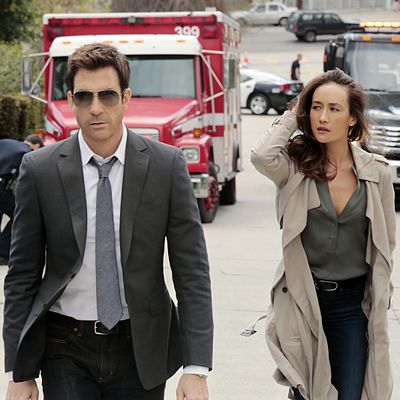
CBS is in the fear business. Terror is one of their most reliable profit centers. For over a decade, the networkÔÇÖs primetime lineup has been dominated by shows that call themselves procedurals (and that often have a bit of creative merit) but which are also (not coincidentally) devoted to stimulating viewersÔÇÖ fear centers and releasing those good, old paranoia endorphins. Though other networks air jeopardy-driven series (see NBCÔÇÖs Law & Order variants and FoxÔÇÖs The Following), only the Eye network has managed to treat them like products and crank them out like cars or laptops, always looking ahead to unveiling a new model. This tendency may have ebbed a bit since the days when multiple CSIs and Without a Trace and Cold Case all shared a grid, but itÔÇÖs still present, as the new series Stalker vividly confirms.
This new show about detectives in the LAPDÔÇÖs Threat Assessment Unit is the brainchild of Kevin Williamson, the mastermind of The Following, and it shares the FoxÔÇÖs showÔÇÖs hammer-blunt aesthetic.┬áAt a press conference this summer, Williamson described Stalker as a ÔÇ£psychologicalÔÇØ series. ThatÔÇÖs not accurate. ThereÔÇÖs a bit of dialogue genuflecting in that direction ÔÇö an early talk between newly installed TAU detective Dylan McDermott and his supervisor, played by Maggie Q, throws around categories from the Diagnostic and Statistical Manual ÔÇö but itÔÇÖs just a fig leaf for what Stalker is really doing. ItÔÇÖs much more concerned with being an example of what my friend Ruby Stevens calls┬áÔÇ£email forwards from That Aunt as shows.ÔÇØ You know what sorts of emails sheÔÇÖs talking about: ones that are theoretically alerting you to real-world dangers but are actually just spreading the same sort of paranoia that makes That Aunt afraid to leave her house after sundown because thatÔÇÖs when the bad people come out. That AuntÔÇÖs emails warn you that people are hiding under cars and slashing peopleÔÇÖs feet, that crowds of teenagers are knocking people out at random, that fake cab drivers are abducting people and taking them to junkyards and raping them, that kind of thing. ItÔÇÖs what the local news does every single night, and cable news on a culturewide level. It makes you feel as if no place is safe. There could be a murderer hiding under your bed right now, or in a closet, or in a crawlspace over your head. TheyÔÇÖre everywhere!
The pilot of Stalker kicks off with a woman being attacked en route to her car by a masked maniac who douses her and her vehicle in gasoline, then sets it on fire, burning her to death. The first few minutes of the show are dominated by her screams. She just screams and screams and screams, and then the flames go Whoosh! and she screams louder, and then the car explodes, and the screen says, STALKER. Two more women are doused in gasoline as the pilot unfolds. They scream and scream and cry and cry. In case their screams and cries arent enough to rattle you and make you jump out of your seat, the score rumbles and goes BOOM! Theres a secondary story about college roommates, each of whom is accused of terrorizing the other. One of the two roommates is a stalker. And wouldnt you know it: According to statistic thrown out by our heroine in an early scene, Anyone can be a stalker  anyone can be a victim.
LetÔÇÖs return for a moment to WilliamsonÔÇÖs ÔÇ£psychologicalÔÇØ assertion, and to his Fox show The Following, by way of making what I hope will be a useful distinction: horror versus terror. The terms are often used interchangeably, but I wish they wouldnÔÇÖt be. Where horror is driven by psychology and philosophy and sometimes theology, terror is driven by fear of violence, period. One type of story is necessarily of a higher artistic order than the second. It takes more intelligence, more creativity, more poetry to do horror than terror. Anybody can hide a maniac in a closet and then have him jump out suddenly while atonal strings shriek on the soundtrack. But not everyone can make a RosemaryÔÇÖs Baby or The Shining or the original Alien, or a David Cronenberg or David Lynch shocker. ThatÔÇÖs something only artists can do, because only true artists can make horror, a vein of story thatÔÇÖs fascinated by peopleÔÇÖs emotional interiors, not just the outer wrapping that can be slashed or stabbed or otherwise violated.
We shouldnÔÇÖt mistake what Williamson is doing on TV for horror, even though he and his networks might sometimes use that word to describe it. The Following and Stalker are terror shows of the crudest sort. They are not trying to create an elegantly unnerving dream space, like Bryan FullerÔÇÖs Hannibal, which can truly be said to be a horror program; despite its Grand Guignol violence and ridiculously varied assortment of serial killers, itÔÇÖs mainly concerned with threats to the mind and the self, which makes its bloodshed seem curiously and rather pleasingly abstract, like the violence in a Grimm fairy tale. WilliamsonÔÇÖs shows are mainly┬áabout threats to bodily integrity: the possibility that somebody might beat, maim, rape or murder you. Stalker is all about those basic fears, and there must be a lot of masochists out there, because shows like that tend to be popular.┬áStalker is not as relentlessly bludgeoning as The Following┬áÔÇö mainly because it doesnÔÇÖt seem to have an overriding ÔÇ£mythologyÔÇØ; not yet, anyway ÔÇö but it is Following-like in that subtlety is, to put it mildly, not a quality itÔÇÖs interested in cultivating. ItÔÇÖs another CBS fear-mongering crime series whose end goal is to make you so scared to go outside that you stay in and watch CBS shows that make you scared to go outside.


